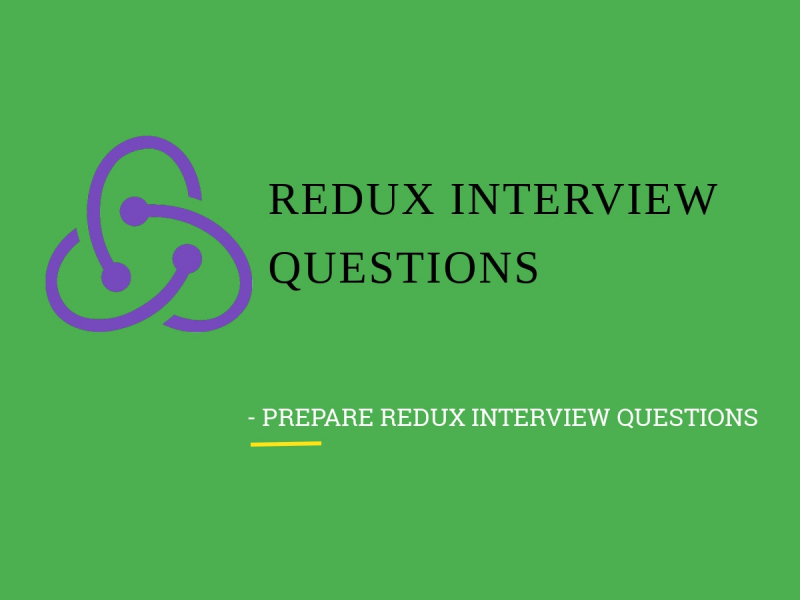Redux interview questions
 Download Redux Interview Questions PDF
Download Redux Interview Questions PDFBelow are the list of Best Redux Interview Questions and Answers
Redux is a high-level tool that is implemented by the developers for easy and simple coding. Redux manages the state of the React applications. Redux helps and improves the elements where Reacts do not do very well. Redux assists in writing applications that behave consistently and run in different environments like server, native and client.
Redux makes the application very easy to tests also. It can perform with any layer of UI and consists of larger ecosystems of add ons that will fit all the needs of the user. In a nutshell, Redux can also be defined as a predictable state container for the JS applications.
Redux can be used in any view library like Vue.js, Angular JS, Ember, Backbone.js, Meteor, and Polymer. Redux with React is the most common combination. In Redux, the same state and action are carried on to the reducer. It will always produce the same results. Redux always notice how odes should be systemized.
Redux also makes the debugging of an application extremely easy. By logging into the state and actions, redux helps to detect the coding errors, bugs, and network errors during production. Redux can also be employed for the rendering of the server-side.
Redux is a state container for the applications on JavaScript that are often known as Redux Store. The store contains the entire state of the app in an unassailable object tree. createStore (reducer, [initial state], [enhancer]) is used to produce a new store. It requires the following three arguments to create a store. They are:
- Reducer: It is a reducing function
- InitialState: This is the initial state of the store
- Enhancer: It is used to add libraries that are third party and middleware for persistent storage, logging and also enhances the Redux Store.
The Redux Store API is small in size and contains four methods like store.getState(), store.dispatch(action), store.subscribe(listener), and Store. replaceReducer(nextReducer).
A reducer in Redux is a function that determines the changes that are done to the state of an application. It implies the action it receives to determine his kind of changes. Redux relies heavily on the reducers that include the state and action of the previous stage to execute the next stage.
The state parameter that is passed on to the reducer function that needs to be the current application state. The update of the state that occurs in the reducer is dependent on the value action.type. If the action.type value present in the action object does not match with the value that is present in the reducer, then the state of default is returned.
Actions are the information payloads that send data from the application to the store. Actions are the only source of store information. Actions can be sent to the sore by applying the store.dispatch (). They represent Plain objects of JavaScripts. Actions are a type of property that states the type of actions that are being performed.
There is no need to define the constants of the action type inside a separate file. It is enough to use string literals for the action types.
If you are implying npm as a project manager, then to install the stable version of the Redux you have to run the following command:
npm install – save redux
If you are not utilizing the npm, then you can access the Redux files from the unpkg, download them and point the project manager to them. Users imply Redux as a collection of modules of CommonJS. These modules can be obtained by importing the Redux from Browserify, Webpack, or a Node environment. Precompiled development UMD and production are included in the dist folder. The source code of the Redux is written in ES2015.
Major differences between Flux and Redux:
- In Flux, the architecture of the application is designed to build web applications of the client-side.
- In Redux, an open-source library of JavaScript is used for the creation of the UI. Redux is implemented in the angular and React development.
- Flux includes multiple whereas Redux includes a single store.
- In Flux all the logic is handled by the store. In Redux all the logic is handled by the reducer.
- Flux makes sure of debugging with the dispatcher. The single store in the Redux makes debugging easier.
- Flux supports all the framework of the client like React, AngularJS, Polymer, and Vue.js. Redux supports front end frameworks like Ember, backbone.js, and Meteor.
Latest Interview Questions-
Silverlight Interview Questions
-
Entity framework interview questions
-
LINQ Interview Questions
-
MVC Interview Questions
-
ADO.Net Interview Questions
-
VB.Net Interview Questions
-
Microservices Interview Questions
-
Power Bi Interview Questions
-
Core Java Interview Questions
-
Kotlin Interview Questions
-
JavaScript Interview Questions
-
Java collections Interview Questions
-
Automation Testing Interview Questions
-
Vue.js Interview Questions
-
Web Designing Interview Questions
-
PPC Interview Questions
-
Python Interview Questions
-
Objective C Interview Questions
-
Swift Interview Questions
-
Android Interview Questions
-
IOS Interview Questions
-
UI5 interview questions
-
Raspberry Pi Interview Questions
-
IoT Interview Questions
-
HTML Interview Questions
-
Tailwind CSS Interview Questions
-
Flutter Interview Questions
-
IONIC Framework Interview Questions
-
Solidity Interview Questions
-
React Js Interview Questions
Subscribe Our NewsLetter
Never Miss an Articles from us.
